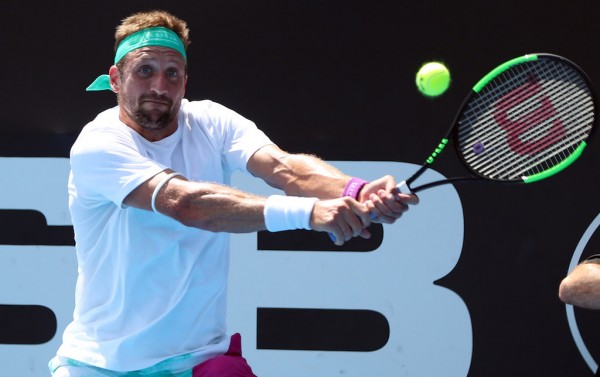By Randy Walker
@TennisPublisher
Tennys Sandgren is sitting on a sofa in a back office at The Boulevard tennis club in Vero Beach, Florida signing photos prior to competing in a charity fund-raising exhibition and is discussing the upcoming 2020 pro tennis season.
The world No. 70 and the quarterfinalist at the 2018 Australian Open is not specific with ranking goals, tournament wins, other than every tennis player’s dream of winning a Grand Slam title.
The No. 6-ranked American man in the ATP rankings is then asked if he knows what his tournament schedule would be for the summer of 2020, specifically in late July of 2020.
“Oh, no,” he said. “I do not have the luxury of some of the highly ranked individuals to pick my schedule a year in advance. So we’ll see where my ranking is at and make decisions from there.”
Sandgren is then presented with the possibility that his summer schedule could include a trip to Tokyo to compete in the 2020 Olympic Games as a member of the U.S. Olympic Tennis Team. Due to the perceived depth of American men in the ATP rankings, Sandgren labels his chances as “an impossible dream.”
A closer look reveals that this impossible dream is actually very possible. Sandgren is then presented with the realistic pathway for him to be part of the U.S. Olympic team. According to the ITF Olympic Rules here: https://cdn.dosb.de/user_upload/Olympische_Spiele/Tokio_2020/internationale_Qualifikationskriterien/ITF_-_Tennis_20190218.pdf, the top 56 direct entries will be accepted, provided each nation does not have no more than four players competing in singles, taken from the ATP rankings for men and WTA rankings for women on June 8, 2020, the first ranking after the 2020 French Open. In the year-end ATP rankings, the men’s cutoff would be around No. 70. Sandgren is ranked No. 68, just inside the cutoff. However, he is the No. 6-ranked American behind No. 19 John Isner, No. 32 Taylor Fritz, No. 36 Reilly Opelka, No. 44 Sam Querrey and No. 47 Frances Tiafoe. Since Isner and Querrey turned down Olympic spots in 2016 and may do so again, and Sandgren would suddenly be the No. 4 American in the selection pecking order and thus in the running for the last singles slot, as long as his ranking allows for a direct entry into the event.
“It would be amazing,” Sandgren said of the potential of being an Olympian. “It’s always been a dream of mine to represent my country in that way and one that felt kind of far-fetched as far as it becoming a reality. It seems as if I might be close. If I can play well and put myself in a good position, then it may just happen.”
Last January, Sandgren won his first career ATP singles title in Auckland, New Zealand and he will return to defend his title – and his ranking points – to start the 2020 season. Doing well in Auckland again will certainly buoy Sandgren’s Olympic hopes as the 250 ranking points are his biggest individual point total of his point total and he has virtually no ranking points to defend from Auckland until the June 8 Olympic ranking deadline. Between Auckland and through French Open, Sandgren did not win an ATP level match.
Sandgren will be fighting for potential Olympic slots with Tiafoe, who has Australian Open quarterfinal points to defend, and Opelka, who has points to defend from his New York Open title. Stevie Johnson, an Olympic team member in 2016 and a bronze medalist in doubles with Jack Sock, is ranked No. 85 and is also not defending many points in the first six months of 2020. Tommy Paul, ranked No. 90, also has to realize that by fulfilling some of his potential in the first six months of 2020 could also see him improving his ranking to threaten for a spot on the team.
Sandgren, age 28, was a former All-American at the University of Tennessee and grinded mainly on the Futures and Challenger tour until he made his breakthrough at the 2018 Australian Open where he reached the quarterfinals with upsets of Stan Wawrinka and Dominic Thiem.
Sandgren donated his time to travel to Vero Beach – halfway between Orlando and West Palm Beach – to play an exhibition match with Jamacian-German Dustin Brown to benefit the Sally Wilkey Foundation, named in honor of a childhood friend, the granddaughter of world No. 1 85s player King van Nostrand and the daughter of Boulevard club manager Jane Wilkey.
“When Jane asked me to come and what she was putting on here and the foundation, there wasn’t a second thought,” said an emotional Sandgren. “Sally was a good friend of mine and it’s been tough. It’s been tough. She lived in a way it’s hard for her not to have an impact on you and to do something small in remembrance of her for a good cause, I would come from halfway around the world.”
For more information on the Sally Wilkey Foundation, email Jane Wilkey at sallywilkeyfoundation@gmail.com

